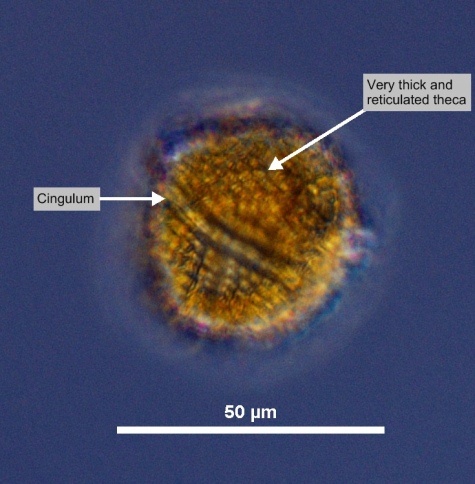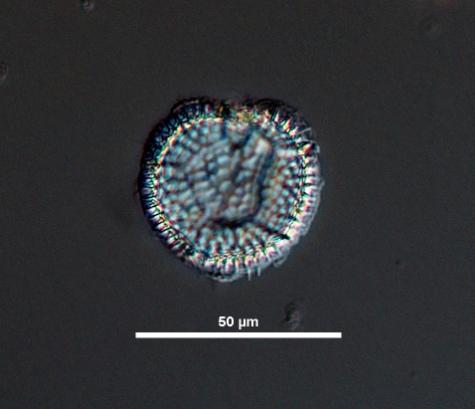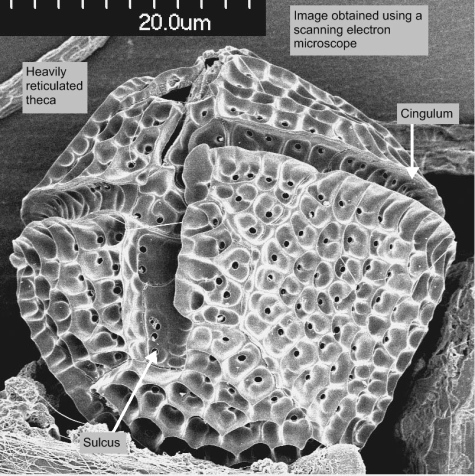





|
Synonym(s)
Protoceratium aceros Bergh 1882
Gonyaulax grindleyi Reinecke 1967
(Horner 2002, Kraberg et al. 2010)
Classification
(Guiry and Guiry 2011)
Lifestyle
Description
Hypotheca
In thecate dinoflagellates, the posterior part of a dinokont cell above the cingulum. The equivalent of a hypocone for naked dinoflagellates.
hypotheca and CloseEpitheca
In thecate dinoflagellates, the anterior part of a dinokont cell above the cingulum. The equivalent of epicone for naked dinoflagellates.
epthica are oval to bowl-shaped. The cell surface is highly CloseReticulated
Resembling a net or having a pattern that resembles a net.
reticulated and cell has numerous brown chloroplasts (Smithsonian 2011).Measurements
Width: 25 - 35 μm
(Smithsonian 2011)
Similar species
Harmful effects
Yessotoxins
(YTXs) A group of toxins produced by some dinoflagellates, including Protoceratium reticulatum. Researchers have observed toxic effects in mice but little is known about it effects on humans or how the toxins work. These toxins do not break down with freezing or cooking, which has lead some countries to regulate the amount of YTXs allowed in shellfish (EFSA 2008).
yessotoxin (YTX), that present risks to human health, aquaculture development and coastal environments (Mitrovic et al. 2004). YTX was first isolated from the scallop Patinopecten yessoensis in Japan 1986 (Paz et al. 2006). YTX produced by P. reticulatum has been reported in New Zealand, Japan, USA, Spain and Norway thus it is a wide-spread toxin (Mitrovic et al. 2004). Blooms of P. reticulatum can cause problems to shellfish producers and consumers because YTX concentrates in many bivalves (clams, oysters, scallops). Although it does not induce diarrhetic effects and does not inhibit protein phosphatases, YTX is still considered to cause diarrheic shellfish poisoning (DSP; Mitrovic et al. 2004). The mode of action and toxic effect of YTX is still not clearly understood. When 100 μg kg-1 of the toxin were injected into the bodies of mice, the mice died. On the other hand, when it was orally administered, the toxins showed a reduced effect (Mitrovic et al. 2004).Habitat
Distribution
This species is widely distributed in temperate and tropical areas and has been reported in Close
Boreal
Relating to the area immediately south of the Arctic.
sub-boreal locations in the summer (Smithsonian 2011). P. reticulatum is also found in North and South Atlantic, Pacific and Indian Oceans and in their associated seas (e.g. Red Sea; Smithsonian 2011).Spring and summer (Smithsonian 2011).
Growth conditions
Irradiance
Amount of solar energy per unit area on a surface (units: μE m-2 sec-1, where E is an Einstein, a mole of photons).
irradiances of 10 - 150 μmol photons m-2 s-1 (Paz et al. 2006). Seamer (2001) established that the most rapid growth of P. reticulatum occurs at salinity of 35, temperature of 21 °C and irradiance of 45 μmol photons m-2 s-1 (Paz et al. 2006). Iron and selenium availability have effects on the growth rate and number of cells of P. reticulatum (Mitrovic et al. 2004). Paz et al. (2006) found that light levels had the biggest impact on the growth of P. reticulatum and on YTX production. At light levels of 50 - 90 μmol photons m-2 s-1, the highest levels of toxins were produced (Paz et al. 2006).Environmental Ranges
Temperature range (°C): -1.893 - 27.583
Nitrate (μmol L-1): 0.041 - 22.805
Salinity: 27.165 - 39.081
Oxygen (mL L-1): 4.586 - 8.589
Phosphate (μmol L-1): 0.085 - 1.771
Close
Silicic acid
A general term to describe chemical compounds containing silicon, oxygen and hydrogen with a general formula of [SiOx(OH)4-2x]n. Diatoms polymerize silicic acid into biogenic silica to form their frustules (Azam and Chisholm 1976).
Silicate (μmol L-1): 0.780 - 34.056(EOL 2011)
Bloom characteristics
Encystment
The act of forming a cyst.
encystment due to a massive bottom-layer inflow of cold oceanic water in the bay (Koike et al. 2006).References
Encyclopedia of Life (EOL). 2011. Protoceratium reticulatum (Claperede and Lachmann) Butschli 1885. http://eol.org/pages/8805068/details. Accessed 15 Nov 2011.
Guiry, M. D. and Guiry, G. M. 2011. P. reticulatum (Claperede and Lachmann) Butschli 1885. http://www.algaebase.org/search/species/detail/?species_id=52624. Accessed 16 Nov 2011.
Horner, R. A. 2002. A Taxonomic Guide To Some Common Phytoplankton. Biopress Limited, Dorset Press, Dorchester, UK. 200.
Koike, K., Horie, Y., Suzuki, T., Kobiyama, A., Kurihara, K., Takagi, K., Kaga, S. N. and Oshima, Y. 2006. Protoceratium reticulatum in northern Japan: environmental factors associated with seasonal occurrence and related contamination of yessotoxin in scallops. Journal of Plankton Research. 28(1): 103-112.
Kraberg, A., Baumann, M. and Durselen, C. D. 2010. Coastal Phytoplankton Photo Guide for Northern European Seas. Verlag Dr. Friedrich Pfeil, Munchen, Germany.203.
Mitrovic, S. M., Amandi, M. F., Mckenzie, L., Furey, A. and James, J. K. 2004. Effects of selenium, iron and cobalt addition to growth and yessotoxin production of the toxic marine dinoflagellate Protoceratium reticulatum in culture. Journal of Experimental Marine Biology and Ecology. 313: 337-351.
Paz, B., Riobo, P., Fernandez, M. L., Fraga, S. and Franco, J. M. 2006. Study of the effect of temperature, irradiance and salinity on growth and yessotoxin production by the dinoflagellate Protoceratium reticulatum in culture by using a kinetic and factorial approach. Marine Environmental Research. 62: 286-300.
Seamer, C. 2001. The production of yessotoxin by Protoceratium reticulatum. M.Sc. Thesis, Victoria University of Wellington, New Zealand.
Smithsonian Institution. 2011. Protoceratium reticulatum (Claperede and Lachmann) Butschli 1885. http://www.sms.si.edu/irlspec/Protoc_reticu.htm. Accessed 16 Nov 2011.
